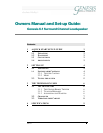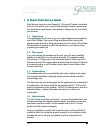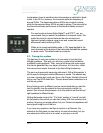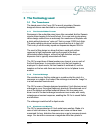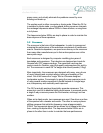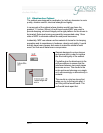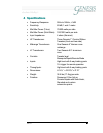
ver 1.0
7
77
7
~ÄëçäìíÉ=ÑáÇÉäáí
ó
paper cones, and virtually eliminate the problems caused by cone
bending and break-up.
The woofers work in either monopole or dipole mode. When the G6.1sr
is switched to dipole mode, a unique phase shifting crossover channels
the midrange frequencies above 200Hz to these woofers, running them
out of phase.
The frequencies below 200Hz are kept in phase in order to maintain the
bass response of these speakers.
3.2 Crossover
The crossover is the brain of the loudspeaker. In order to manage and
maximize the performance of the extensive complement of transducers
used in Genesis loudspeakers, we spend more money on the crossover
than many other manufacturers put in their entire speaker even at the
same price range.
Each crossover is designed by computer modelling plus years of
knowledge and experience. The inductors are designed and made for
Genesis with OFC copper windings. The capacitors used are also
custom made for Genesis, using high-quality polypropylene-film and tin-
foil. The crossovers in each G6.1sr weighs over seven pounds (3.2kg)!
More importantly, the crossovers are designed with many, many hours
of music listening and constant refining, tuning and tweaking of the
circuit. Out of this comes the “magic” that is a Genesis-designed
loudspeaker system. For example, by going the more expensive route
of using several smaller capacitors in parallel instead of a single large
one, transparency and musicality were improved.
The G6.1sr actually employs three totally separate crossovers. This
accounts in part for its absolute fidelity performance. In monopole mode,
a single 3-way crossover powers the front tweeter, midrange, and two
woofers.
When set in dipole mode, two crossovers are used. One drives one face
of the speaker with a tweeter and woofer. The other is a unique phase-
shifting crossover that splits the frequency range at approximately
200Hz. The frequencies above this are driven out of phase to the other
face, creating the dipole effect. The frequencies below 200Hz are in
phase to the other face in order to maintain the bass performance.



